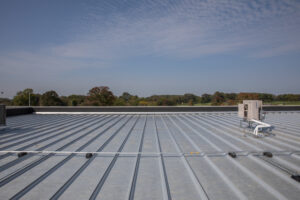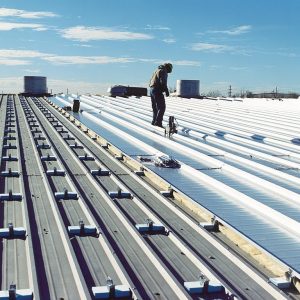Roofing contractors often come across existing metal roofs that require rehabilitation. While coating is a popular option for refurbishing metal roofs, it is crucial to assess whether a roof is suitable for coating before offering it as a solution. This blog post delves into common issues that may render a metal roof unsuitable for coating and explores alternative retrofit options that may be more appropriate.

Common Issues:
Metal roofs possess unique characteristics that differentiate them from other roofing types. It is essential to identify signs that indicate a roof may not be suitable for coating. Here are some cases where alternative solutions should be considered:
- Corrosion: While some level of corrosion is expected in older metal roofs, severe corrosion can compromise the structural integrity of the roof. Prolonged leaks can cause damage to purlins and eave struts, weakening the building’s structure. If corrosion is severe and roof panels are perforated, coating may not be viable. Additionally, coating over severely corroded areas can create safety hazards.
- Fastener Problems: Leaky or corroded fasteners can result in weak areas in the roof panels surrounding them. Fasteners play a critical role in securing the roof and transferring diaphragm strength to the structure. Merely capping the fasteners with coatings does not address the underlying structural issues. Improperly coating a compromised roof can hide problems and potentially expose contractors to liability if a structural failure occurs.
- Thermal Movement: Metal roofs experience significant thermal expansion and contraction. This movement is especially pronounced in roofs with exposed structural fasteners or long run panels. Excessive bending, cracking, slotting of fastener holes, or torn-apart end laps indicate excessive movement. Coating, despite its flexibility, will only mask the issue temporarily, and the problem will likely recur.
- Penetrations: Roof-mounted equipment and pipe penetrations can cause ongoing problems in metal roofs due to incorrect installation and differential movement between the roof and the equipment. While coating may temporarily address leaks, the substantial forces involved often require further attention. Minimizing roof-mounted items and ensuring proper water flow is essential to prevent ponding.
- Additional Weight: Metal roofs have weight limitations. Sagging of purlins between frames or significant dimpling around fastener heads may indicate excessive added weight. Building modifications, such as suspended or mounted equipment, can exceed the roof’s original load capacity, compromising compliance with building codes and compromising occupant safety.
- Water Movement: Standing Seam Metal Roof Systems expand and contract on the clips attached to the structural system. This movement will cause the coating to deteriorate and water to get trapped between the coating and surfaces

Alternative Options:
If a metal roof exhibits any of these issues, coating may not be the most suitable solution. Several alternative retrofit options can be considered:
- New Metal Roof Recover: Removing and replacing the existing metal roof with a new one is a comprehensive solution. This approach ensures a fresh start with a structurally sound roof that meets current standards.
- Thermoplastic Polyolefin (TPO) Overlay: Applying a TPO overlay involves installing a new TPO membrane directly over the existing metal roof. This option provides enhanced waterproofing and durability.
- Metal-over-Metal Retrofit System: This solution involves installing a new metal roof directly over the existing metal roof. It offers improved structural integrity and added insulation, contributing to energy efficiency.

Conclusion:
While coating is a common method for rehabilitating metal roofs, it is crucial to assess the roof’s suitability before proceeding. Corrosion, fastener problems, thermal movement, penetrations, and additional weight can indicate that coating may not be a viable option. In such cases, exploring alternative retrofit options, such as a new metal roof recover, TPO overlay, or metal-over-metal retrofit system, is recommended. As roofing professionals, conducting thorough assessments, seeking expert advice when needed, and providing clients with the best-suited solutions are essential for successful roof rehabilitation projects.
